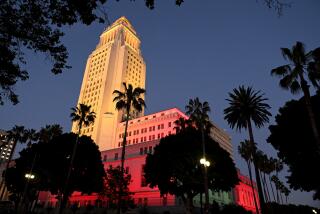Council Acts to Get Citizens in on Planning
- Share via
When a mini-mall is proposed for a neighborhood, how does an enraged citizen complain and make it count?
That down-to-earth question stirred a City Hall dispute Wednesday, which, on the surface, seemed procedural but really got to the heart of the current Los Angeles slow-growth controversy.
To understand the dispute, suppose you are a homeowner in Chatsworth who feels that there are enough mini-malls in the neighborhood. You are appalled to learn that another one is going to be built down the street. In a small way, you join Los Angeles’ slow-growth movement. Growth, after all, is merely the sum of all the mini-malls, big malls, apartments and high-rises built in the city.
You want to: (1) stop the mini-mall, and (2) find out who in city government was responsible for permitting it. Whom do you call?
You presently have three choices, your area’s Los Angeles City Council member, Hal Bernson, Mayor Tom Bradley or, if you are really mad, both. Bernson and other council members want to be the ones to hear from you. But Bradley, seeking a stronger role in city planning because he has been criticized as pro-growth, wants a say in such matters, so he would like to know your feelings, too.
On Wednesday, three members of the City Council made a move aimed at making sure they would hear from you first.
Bernson, chairman of the council’s Planning Committee, and his two committee colleagues, Michael Woo of the Hollywood area and Ruth Galanter, who represents an area from Crenshaw to Los Angeles International Airport, called a press conference to explain their strategy. They announced a committee hearing next week to hear a proposal to create local citizens advisory committees to deal with zoning and planning. Council members would appoint the members.
The committees would have no power to write laws. The council makes the final decision on these plans, subject to a mayoral veto. But the committee recommendations would go into the decision-making mix that shapes council actions on zoning projects such as mini-malls in residential areas. Citizens concerned about such development could make their first complaints to these committees as development plans for neighborhoods are being drawn.
The Wednesday press conference followed one held Monday by Bradley and two of his top advisers, Dan Garcia, president of the Planning Commission, and Kenneth C. Topping, who heads the Planning Department.
Bradley pushed for community planning boards that would work on revision of the 35 community plans that, added up, are shaping Los Angeles’ growth. While the administration called for “close coordination with council district offices,” officials said that the membership of the planning boards would be appointed by both the mayor and council members.
Bradley clearly wanted a piece of the planning pie.
Aides indicated that his proposal was a reaction to months of criticism of administration planning policy, which had been attacked by critics such as Councilman Zev Yaroslavsky, a potential Bradley mayoral election opponent in 1989. The criticism culminated in the 1986 approval of Proposition U, a slow-growth measure, and the defeat this year of Bradley ally Pat Russell, who was unseated from her council seat by Galanter. Galanter successfully portrayed Russell as a pro-development lawmaker who had allowed too much building along the coast, in Westchester and around the airport.
‘Substantial Public Issue’
“Planning has become a substantial public issue in Los Angeles,” Topping wrote in a report accompanying the mayor’s proposal. “Rapid growth and increased densities have created an exciting new skyline and diversity of development. At the same time, citizen complaints have arisen about increased congestion, traffic, noise and other urban problems. Citywide and community plans prepared in the 1960s and 1970s were not consistently updated.”
At the Wednesday press conference, Galanter, while not criticizing the mayor, expressed concern that his plan would impede council members’ ability to react quickly to neighborhood development disputed. Clearly, she felt that the immediate concerns of her constituents would be lost amid Bradley administration concern for the big picture, and she wanted a citizens committee, appointed by her, that could quickly make decisions on problems they were familiar with as neighbors.
“As a council member, I know things happen quickly, and it is important to have people active on a day-to-day basis,” she said.
Bernson said of Bradley, “In my area, I would not welcome his participation.” Bernson introduced members of district planning advisory committees he has appointed on his own over the last few years and said they had created an atmosphere of responsiveness to citizens unhappy over development.
The dispute will begin to be settled next week, probably peacefully. “The idea is not to conflict with the mayor,” Bernson said. But while the dispute goes on, it will provide a good picture of why it is so difficult to settle those disputes over construction of mini-malls.
More to Read
Sign up for Essential California
The most important California stories and recommendations in your inbox every morning.
You may occasionally receive promotional content from the Los Angeles Times.













